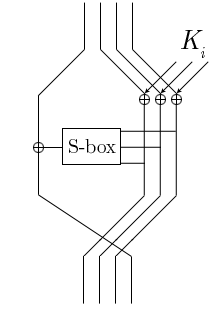Blowfish is a symmetric-key block cipher, designed in 1993 by Bruce Schneier and included in many cipher suites and encryption products. Blowfish provides a good encryption rate in software, and no effective cryptanalysis of it has been found to date. However, the Advanced Encryption Standard (AES) now receives more attention, and Schneier recommends Twofish for modern applications.
In cryptography, a block cipher is a deterministic algorithm that operates on fixed-length groups of bits, called blocks. Block ciphers are the elementary building blocks of many cryptographic protocols. They are ubiquitous in the storage and exchange of data, where such data is secured and authenticated via encryption.

The Data Encryption Standard is a symmetric-key algorithm for the encryption of digital data. Although its short key length of 56 bits makes it too insecure for modern applications, it has been highly influential in the advancement of cryptography.
In cryptography, a Feistel cipher is a symmetric structure used in the construction of block ciphers, named after the German-born physicist and cryptographer Horst Feistel, who did pioneering research while working for IBM; it is also commonly known as a Feistel network. A large number of block ciphers use the scheme, including the US Data Encryption Standard, the Soviet/Russian GOST and the more recent Blowfish and Twofish ciphers. In a Feistel cipher, encryption and decryption are very similar operations, and both consist of iteratively running a function called a "round function" a fixed number of times.

In cryptography, an SP-network, or substitution–permutation network (SPN), is a series of linked mathematical operations used in block cipher algorithms such as AES (Rijndael), 3-Way, Kalyna, Kuznyechik, PRESENT, SAFER, SHARK, and Square.
In cryptography, Skipjack is a block cipher—an algorithm for encryption—developed by the U.S. National Security Agency (NSA). Initially classified, it was originally intended for use in the controversial Clipper chip. Subsequently, the algorithm was declassified.

In cryptography, LOKI97 is a block cipher which was a candidate in the Advanced Encryption Standard competition. It is a member of the LOKI family of ciphers, with earlier instances being LOKI89 and LOKI91. LOKI97 was designed by Lawrie Brown, assisted by Jennifer Seberry and Josef Pieprzyk.
In cryptography, the Generalized DES Scheme is a variant of the DES symmetric-key block cipher designed with the intention of speeding up the encryption process while improving its security. The scheme was proposed by Ingrid Schaumuller-Bichl in 1981.

In cryptography, RC2 is a symmetric-key block cipher designed by Ron Rivest in 1987. "RC" stands for "Ron's Code" or "Rivest Cipher"; other ciphers designed by Rivest include RC4, RC5, and RC6.
In cryptography, Khufu and Khafre are two block ciphers designed by Ralph Merkle in 1989 while working at Xerox's Palo Alto Research Center. Along with Snefru, a cryptographic hash function, the ciphers were named after the Egyptian Pharaohs Khufu, Khafre and Sneferu.
In cryptography, Madryga is a block cipher published in 1984 by W. E. Madryga. It was designed to be easy and efficient for implementation in software. Serious weaknesses have since been found in the algorithm, but it was one of the first encryption algorithms to make use of data-dependent rotations, later used in other ciphers, such as RC5 and RC6.

In cryptography, ICE is a symmetric-key block cipher published by Matthew Kwan in 1997. The algorithm is similar in structure to DES, but with the addition of a key-dependent bit permutation in the round function. The key-dependent bit permutation is implemented efficiently in software. The ICE algorithm is not subject to patents, and the source code has been placed into the public domain.
Bart Preneel is a Belgian cryptographer and cryptanalyst. He is a professor at Katholieke Universiteit Leuven, in the COSIC group.
Introduced by Martin Hellman and Susan K. Langford in 1994, the differential-linear attack is a mix of both linear cryptanalysis and differential cryptanalysis.
In cryptography, integral cryptanalysis is a cryptanalytic attack that is particularly applicable to block ciphers based on substitution–permutation networks. It was originally designed by Lars Knudsen as a dedicated attack against Square, so it is commonly known as the Square attack. It was also extended to a few other ciphers related to Square: CRYPTON, Rijndael, and SHARK. Stefan Lucks generalized the attack to what he called a saturation attack and used it to attack Twofish, which is not at all similar to Square, having a radically different Feistel network structure. Forms of integral cryptanalysis have since been applied to a variety of ciphers, including Hierocrypt, IDEA, Camellia, Skipjack, MISTY1, MISTY2, SAFER++, KHAZAD, and FOX.
In cryptography, M6 is a block cipher proposed by Hitachi in 1997 for use in the IEEE 1394 FireWire standard. The design allows some freedom in choosing a few of the cipher's operations, so M6 is considered a family of ciphers. Due to export controls, M6 has not been fully published; nevertheless, a partial description of the algorithm based on a draft standard is given by Kelsey, et al. in their cryptanalysis of this family of ciphers.

In cryptography, Twofish is a symmetric key block cipher with a block size of 128 bits and key sizes up to 256 bits. It was one of the five finalists of the Advanced Encryption Standard contest, but it was not selected for standardization. Twofish is related to the earlier block cipher Blowfish.
This article summarizes publicly known attacks against block ciphers and stream ciphers. Note that there are perhaps attacks that are not publicly known, and not all entries may be up to date.
This is a timeline of the public releases or introductions of computer encryption algorithms.
In cryptography, a round or round function is a basic transformation that is repeated (iterated) multiple times inside the algorithm. Splitting a large algorithmic function into rounds simplifies both implementation and cryptanalysis.






